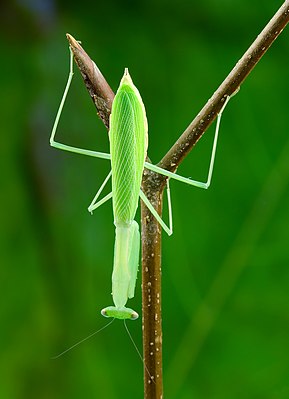Egyptian praying mantis
| Egyptian praying mantis | ||||||||||||
|---|---|---|---|---|---|---|---|---|---|---|---|---|

Egyptian praying mantis ( Miomantis paykullii ), female |
||||||||||||
| Systematics | ||||||||||||
|
||||||||||||
| Scientific name | ||||||||||||
| Miomantis paykullii | ||||||||||||
| Stål , 1871 |
The Egyptian mantis ( Miomantis paykullii ) or Pharaomantis is a Mantis from the family of Mantidae , subfamily Miomantinae. The species is able to reproduce parthenogenesically .
features

Males reach a body length of 35 millimeters, females one of 45 millimeters. The basic color of the Egyptian praying mantis is green, but there are also specimens with a beige-brown basic color.
Similar species
The Egyptian praying mantis resembles some types of mantis, such as the Ghana praying mantis ( Sphodromantis lineola ) or the European praying mantis ( Mantis religiosa ), which at 80 millimeters are significantly larger than the Egyptian praying mantis.
Occurrence
The Egyptian praying mantis lives in Africa in the countries of Egypt , Ivory Coast , Ghana , Togo , Cameroon , Kenya , Mozambique , Niger , Chad , Uganda and Senegal . There she lives in shrubs, bushes and grasses in rather dry steppe areas. The Egyptian praying mantis is well camouflaged in its habitat and is difficult to spot on the grass on which it lurks.
Way of life
Females of the Egyptian praying mantis reach a lifespan of 8 months. They need 7 molts for this life cycle. Males live to be 6 months and roam 6 moults.
Multiplication
Copulation takes 2 to 5 hours. About 7 days after mating, about 10 ooths are deposited, from which 20 to 50 larvae hatch. Reproduction by virgin generation is also possible.
nutrition
The young animals, which are very small at first, feed on very small insects, such as springtails . Fruit flies are one of the largest prey animals.
Adults feed on flies , furnacefish , like the larvae also on springtails and on small or not yet fully grown long- and short-feeler terrors .
Taxonomy
The species was described by Carl Stål in 1871 . The epithet paykullii was chosen in honor of the Swedish naturalist Gustaf von Paykull . Within the subfamily Miomantinae it is counted to the tribe Miomantini , which includes nine genera. The second tribe of the Miomantinae are the Rivetinini with 18 genera.
Individual evidence
- ^ Tree of Life Web Project: Miomantis . 2005
- ^ Carl Stål: Orthoptera quaedam africana. Öfversigt af Konglia Vetenskaps-Akademiens förhandlingar, 3, pp. 375–401, 1871
- ↑ Martin Stiewe: Recent Mantodea Systematic (present-day) . Retrieved March 10, 2012
literature
- Reinhard Ehrmann: Mantodea: praying mantises of the world. Natur und Tier Verlag, Münster 2002, ISBN 3-931587-60-6
- Carl Stål: Orthoptera quaedam africana. Öfversigt af Konglia Vetenskaps-Akademiens förhandlingar, 3, pp. 375–401, 1871 (first description)
